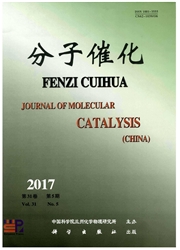

 中文摘要:
中文摘要:
我们研究了镍-铁双金属催化剂在乙酸水蒸气重整制氢反应中的催化性能.研究结果显示单金属铁催化剂对乙酸重整反应活性很低,但是对一氧化碳的中温变换反应有较好的催化性能.镍单金属催化剂对乙酸水蒸气重整制氢反应有非常好的初始催化活性,但是催化剂的长期稳定性很差.镍-铁复合催化剂的低温活性(623 K)和长期稳定性(100 h)都远好于单金属催化剂.这主要是因为铁的加入可以促进镍的分散,形成更多的表面活性位同时有助与防止镍的烧结.我们也对乙酸重整反应中的两个主要气体副产物(一氧化碳和甲烷)的反应路径进行了分析.研究发现反应温度决定一氧化碳和甲烷的反应路径.673 K是一个临界温度.低于此温度,甲烷的产生主要来自于一氧化碳和二氧化碳的甲烷化,而高于673 K,甲烷主要来自于乙酸的直接裂解.对于一氧化碳副产物而言,低于673 K其主要来自于乙酸的裂解或者不充分的水蒸气重整反应,而高于673 K产生的一氧化碳则主要来自与逆水煤气变换反应.
 英文摘要:
英文摘要:
Steam reforming of acetic acid for hydrogen generation was investigated over bimetallic Ni-Fe catalysts,monometallic Ni and Fe catalysts to understand behaviours of nickel and iron during the reforming. Monometallic Fe is not active for acetic acid reforming but is important to transform the CO intermediate to H2 and CO2. Monometallic Ni is active for acetic acid reforming but is not stable with prolonged reaction time. The combination of these two metals with distinct catalytic capabilities makes the bimetallic Ni-Fe catalyst far superior to the monometallic Ni or Fe catalyst in terms of both activity and stability at the temperature as low as 623 K. The reaction pathways of the two gaseous by-products,methane and CO,were explored as well over the Ni-Fe catalyst. It was found that the 673 K was a critical temperature when the reaction pathways for both methane and CO started to shift. Below 673 K,methane mainly is formed from methanation of CO and CO2,while above this temperature methane is mainly formed from the decomposition of acetic acid. As for CO,below 673 K,it is mainly formed from the decomposition of acetic acid and the insufficient steam reforming of acetic acid. Above this temperature the reverse water gas shift reaction are the dominate way for CO formation.
 同期刊论文项目
同期刊论文项目
 同项目期刊论文
同项目期刊论文
 期刊信息
期刊信息
